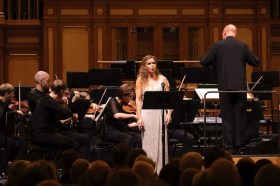Interrupting a Crisis Image: Daniel James Grant.
The creative dictum to ‘share what you know’ has been taken to its logical conclusion by Georgina Cramond in a work combining songwriting, storytelling and a willingness to confront her pain, panic and struggles with mental health. A clear storyline, pleasant singing style and structured songs combine with moments of dark humour that lighten but emphasise the difficult content of Interrupting a Crisis.
Her first panic attack happens over a trivial office incident, Cramond re-enacting the event, describing her physical reactions with biological explanations. She takes us through her subsequent process of diagnosis, the GP visit and the mental health check, how she organised access to a therapist… while this applies to many Australians with mental health episodes, it’s not something that many would care to recall in detail, let alone clearly enough to recount on stage.
Taking her therapist’s advice to acquire a hobby, Cramond enrols on a songwriting course, discovering a passion that keeps her demons at bay. She shares the ups and down of her songwriting and performing career, performing songs that are even more personal in their lyrical statements than the spoken lines of this incredibly open confessional piece.
Cramond’s relentless honesty extends further to her personal life and examining her relationship with food as she develops an eating disorder. Her wrenching account of the minutiae of the feelings behind her rejection of food, her sense of worthlessness and rejection of self, amazes with her determination to share this experience on stage.
The clear recounting is emphasised with nowhere to physically hide, the only stage prop the keyboard with which she accompanies her own songs, containing so much pain and honesty in their lyrics. The tale is confronting, and punctuated with humorous asides that also refuse to gloss over the dark experiences, causing audiences to laugh while weeping.
Cramond’s story is supported by strong technical development, particularly in the lighting design and video effects. Working with designer Clare Testoni’s simple and stark pattern to create contrast in the black box stage, Rhiannon Petersen’s lighting design and selection of animated segments to illustrate the feelings of stories are effective and sympathetic, while George Ashforth’s sound design subtly enhances the changing moods.
Director Finn O’Branagain has employed her dramaturgical skills to develop a show that is astounding in its direct honesty, and hopefully protecting Cramond as she shares her story. The tale is accessible and relatable while remaining deeply personal, rejecting facile calls for sympathy and emphasising the work in progress nature of life with anxiety, with no final happy endings in sight.
Independent theatre is full of surprises, and Interrupting a Crisis is a fascinating work right at home in The Blue Room Theatre. Providing food for thought long after the closing notes, Cramond interrupts her own crisis and gives hope to others who may feel alone.
Rating: 3 1/2 stars out 5
Interrupting a Crisis
Presented by The Blue Room Theatre and Ribs
Writer and Performer Georgina Cramond
Director Finn O’Branagain
Designer Clare Testoni
Lighting designer Rhiannon Petersen
Stage Manager Rachael Woodward
Sound designer George Ashforth
The Blue Room Theatre, Perth Cultural Centre
16 May – 3 June 2017
Lifeline 13 11 14





